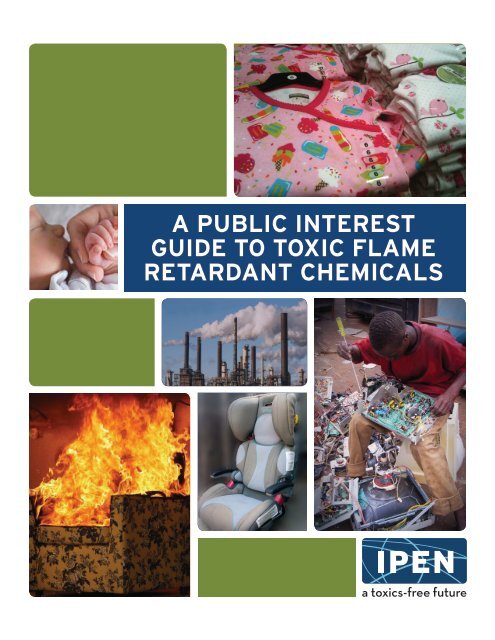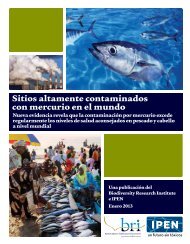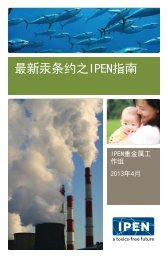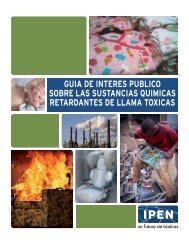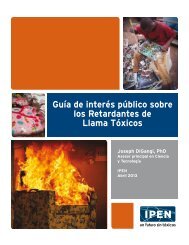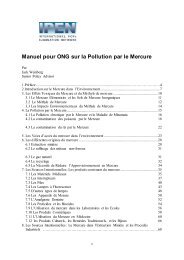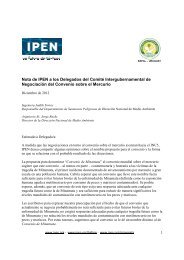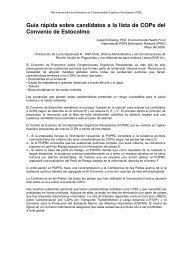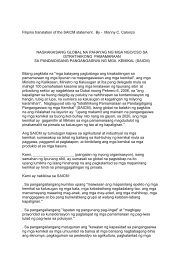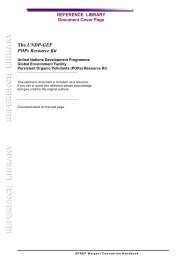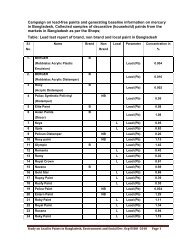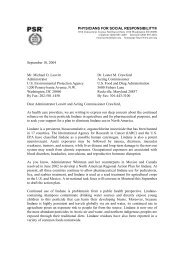A Public Interest Guide to Toxic Flame Retardant Chemicals
A Public Interest Guide to Toxic Flame Retardant Chemicals
A Public Interest Guide to Toxic Flame Retardant Chemicals
You also want an ePaper? Increase the reach of your titles
YUMPU automatically turns print PDFs into web optimized ePapers that Google loves.
A PUBLIC INTEREST<br />
GUIDE TO TOXIC FLAME<br />
RETARDANT CHEMICALS
“WE DID NOT FIND FLAME RETARDANTS IN FOAM TO PROVIDE ANY SIGNIFI-<br />
CANT PROTECTION,” SAID DALE RAY, A TOP OFFICIAL WITH THE CONSUMER<br />
PRODUCT SAFETY COMMISSION…” — CHICAGO TRIBUNE, MAY 6, 2012<br />
2<br />
Image courtesy of U.S. Consumer Product Safety Commission
A PUBLIC INTEREST GUIDE TO TOXIC<br />
FLAME RETARDANT CHEMICALS<br />
Joseph DiGangi, PhD<br />
Senior Science and Technical Advisor<br />
IPEN<br />
ipen@ipen.org<br />
www.ipen.org<br />
CONTENTS<br />
1. INTRODUCTION .......................................................4<br />
2. INFORMATION SOURCES ...............................................4<br />
3. FIRE SAFETY .........................................................5<br />
4. SUBSTANCES MARKETED AS FLAME RETARDANTS ....................... 7<br />
5. INDUSTRY ACTIONS: A HISTORY OF DECEPTION ......................... 12<br />
6. ADDRESSING WASTES CONTAINING FLAME RETARDANT CHEMICALS ........15<br />
7. REGULATORY POLICY. . . . . . . . . . . . . . . . . . . . . . . . . . . . . . . . . . . . . . . . . . . . . . . . . 18<br />
8. PUBLIC INTEREST RECOMMENDATIONS AND ACTIONS ...................22<br />
9. CONCLUSION ........................................................24<br />
10. ABBREVIATIONS ....................................................26<br />
11. REFERENCES .......................................................26<br />
A PUBLIC INTEREST GUIDE TO TOXIC FLAME RETARDANT CHEMICALS<br />
3
1. INTRODUCTION<br />
<strong>Toxic</strong> chemicals marketed as flame retardants are widely present in our homes, our bodies,<br />
and even in our wastes. Due <strong>to</strong> increasing public health concerns, actions <strong>to</strong> regulate<br />
and eliminate them have occurred globally, nationally, and locally. However, the chemical<br />
industry continues <strong>to</strong> formulate new substances with similar <strong>to</strong>xic properties that are<br />
then incorporated in<strong>to</strong> many products. These substances are now found throughout the<br />
global environment, wildlife, and people, and even in areas far from where these substances<br />
are used or produced, like the Arctic.<br />
This public interest guide is a concise introduction <strong>to</strong> the science and politics of <strong>to</strong>xic<br />
flame retardants and includes a section on possible actions that can help reduce the<br />
harms of <strong>to</strong>xic chemicals <strong>to</strong> human health and the environment. It aims <strong>to</strong> raise public<br />
awareness about this harmful class of substances and stimulate action <strong>to</strong> reform how<br />
chemicals are produced, used, and substituted so that harms from <strong>to</strong>xic chemical exposure<br />
can ultimately be eliminated. While reading from start <strong>to</strong> finish provides a view<br />
of all the issues, readers are also encouraged <strong>to</strong> jump <strong>to</strong> the section of most interest <strong>to</strong><br />
them, the same way they would use a <strong>to</strong>ur guide.<br />
2. INFORMATION SOURCES<br />
This <strong>Guide</strong> primarily uses three key sources of information: 1) San An<strong>to</strong>nio Statement on<br />
Brominated and Chlorinated <strong>Flame</strong> <strong>Retardant</strong>s; 2) Chicago Tribune investigative series,<br />
“Playing with Fire”; and 3) Reports from UN processes such as the S<strong>to</strong>ckholm Convention<br />
on POPs and the Strategic Approach <strong>to</strong> International <strong>Chemicals</strong> Management. Links<br />
<strong>to</strong> these sources are provided in the References section.<br />
TOXIC CHEMICALS MARKETED AS<br />
FLAME RETARDANTS DO NOT PROVIDE<br />
FIRE SAFETY BENEFIT IN THE AMOUNTS<br />
ACTUALLY USED IN PRODUCTS<br />
In 2010, more than 200 scientists from 30 countries signed the San An<strong>to</strong>nio Statement<br />
in an effort <strong>to</strong> publicly raise concerns and call attention <strong>to</strong> neglected scientific information<br />
on bromine- and chlorine-containing flame retardants as a class. Environmental<br />
Health Perspectives published the fully-referenced Statement along with an edi<strong>to</strong>rial by<br />
Linda Birnbaum, Direc<strong>to</strong>r of the US National Institute of Environmental Health Sciences<br />
and the US National <strong>Toxic</strong>ology Program, and Ake Bergman, a prominent Swedish scientist<br />
and Direc<strong>to</strong>r of the Environmental Chemistry Unit in the Department of Materials<br />
and Environmental Chemistry at S<strong>to</strong>ckholm University. Birnbaum and Bergman de-<br />
4
scribed the Statement as, “… a call for attention <strong>to</strong> a continuing pattern of unfortunate<br />
substitution…” and “…a reasoned plea from the scientific community…”<br />
The Chicago Tribune published an in-depth four-part series on <strong>to</strong>xic chemicals marketed<br />
as flame retardants in May 2012. The four front-page articles described the widespread<br />
presence of the substances, and exposed how the chemicals do not actually provide fire<br />
safety benefit. The series exposed actions by the chemical industry <strong>to</strong> dis<strong>to</strong>rt science,<br />
invent phony industry advocacy groups, and even pay a prominent physician <strong>to</strong> invent<br />
testimony about non-existent patients <strong>to</strong> undermine legislative proposals <strong>to</strong> protect<br />
public health. The series shows how the <strong>to</strong>bacco industry used fire marshals <strong>to</strong> focus<br />
attention on production of flame retarding furniture with <strong>to</strong>xic chemicals instead of<br />
fire-safe cigarettes. Finally the series examines the weaknesses of a current fire safety<br />
standard and a chemical regula<strong>to</strong>ry system that allow these substances <strong>to</strong> be used in<br />
the first place. The series spurred senior Illinois Sena<strong>to</strong>r Richard Durbin <strong>to</strong> call for federal<br />
action by the US government on the matter, citing the startling facts reported in the<br />
series.<br />
<strong>Toxic</strong> chemicals marketed as flame retardants have attracted global attention and action<br />
through UN agreements. In 2009, more than 170 governments agreed on the global<br />
elimination of three flame retardants through the S<strong>to</strong>ckholm Convention. The widespread<br />
presence of flame retardant chemicals in electronic wastes led delegates participating<br />
in the Strategic Approach <strong>to</strong> International <strong>Chemicals</strong> Management <strong>to</strong> declare<br />
these types of hazardous chemicals <strong>to</strong> be a global emerging policy issue. At the same<br />
meeting, similar concerns about the lack of information on flame retardants and other<br />
types of <strong>to</strong>xic chemicals in consumer products led delegates from more than 100 countries<br />
<strong>to</strong> launch an ongoing project <strong>to</strong> tackle this problem by the United Nations Environment<br />
Programme (UNEP).<br />
3. FIRE SAFETY<br />
3.1 TOXIC CHEMICALS MARKETED AS FLAME RETARDANTS DO NOT<br />
ACTUALLY WORK IN PRODUCTS<br />
The chemical industry claims that adding <strong>to</strong>xic chemicals marketed as flame retardants<br />
<strong>to</strong> polyurethane foam (known in some countries as “foam rubber”) makes the difference<br />
“…between life and death.” However, in an interview with the Chicago Tribune, Dale Ray,<br />
a <strong>to</strong>p official with the US Consumer Product Safety Commission said, “We did not find<br />
flame retardants in foam <strong>to</strong> provide any significant protection.” Ray also said that the<br />
amount of smoke is similar in flame-retarded products and that most fire victims die of<br />
smoke inhalation, not flames. The federal agency now believes that the best way <strong>to</strong> fireproof<br />
furniture is <strong>to</strong> require upholstery <strong>to</strong> resist smoldering sources of ignition such as<br />
cigarettes. The agency notes that, “Most of the furniture sold <strong>to</strong>day already is covered<br />
with fabrics that comply with the proposed smolder standard…If furniture fabric s<strong>to</strong>ps<br />
a fire from starting in the first place…there is no reason <strong>to</strong> keep adding flame retardant<br />
chemicals <strong>to</strong> the foam underneath.” Underwriters Labora<strong>to</strong>ries also found that placing<br />
A PUBLIC INTEREST GUIDE TO TOXIC FLAME RETARDANT CHEMICALS<br />
5
a fire-resistant layer that does not contain<br />
<strong>to</strong>xic flame retardant chemicals between<br />
foam and fabric was much more effective<br />
than adding <strong>to</strong>xic flame retardant chemicals<br />
<strong>to</strong> the foam.<br />
3.2 NO FIRE SAFETY BENEFIT IN<br />
FURNITURE<br />
The chemical industry claims that adding<br />
<strong>to</strong>xic flame retardant chemicals <strong>to</strong> foam<br />
used in furniture gives people more time<br />
<strong>to</strong> escape a fire. A burn study cited by<br />
the industry showed that only very large<br />
amounts of chemicals slowed a fire. Yet,<br />
the chemical industry used the study <strong>to</strong><br />
claim that addition of <strong>to</strong>xic flame retardant<br />
chemicals <strong>to</strong> consumer products gives a<br />
15-fold increase in escape time in case of<br />
a fire. The Chicago Tribune interviewed<br />
the study’s author, Vy<strong>to</strong> Babrauskas, who<br />
called such claims, “… ‘<strong>to</strong>tally bogus’<br />
because the amounts of flame retardants<br />
in the burned samples in his tests were so<br />
much greater than what is found in typical<br />
consumer items.” Babrauskas noted<br />
that since furniture is covered with fabric,<br />
the flames from the burning fabric quickly<br />
overwhelm the foam, even if <strong>to</strong>xic chemicals<br />
are added. He added that household<br />
furniture often contains enough chemicals<br />
<strong>to</strong> pose health threats but not enough <strong>to</strong><br />
stem fires — “…the worst of both possible<br />
worlds.” Babrauskas called the chemical<br />
industry claims “flat-out deceptive” and<br />
said that they should s<strong>to</strong>p misrepresenting<br />
his work in order <strong>to</strong> sell more flame retardants.<br />
3.3 NO FIRE SAFETY BENEFIT IN<br />
ELECTRONICS<br />
The chemical industry claims that adding<br />
<strong>to</strong>xic flame retardant chemicals <strong>to</strong> plastics<br />
used in electronics provides a large<br />
fire safety benefit. However, the Chicago<br />
Tribune investigation found that this claim<br />
is based on unscientific methods. In 1997<br />
as questions were being raised in Europe<br />
about flame retardants in electronics, the<br />
chemical industry, “…began searching for<br />
evidence that the benefits of flame retardants<br />
in those products outweighed any<br />
risks.” The Tribune describes how three<br />
industry researchers unscientifically used<br />
a finding of only eight TV fires in Sweden<br />
<strong>to</strong> extrapolate <strong>to</strong> all of Europe and claim<br />
that it experienced 165 TV fires per million<br />
sets each year. Even more surprising (and<br />
completely unscientific) was the industry<br />
claim that since the US rate was five TV<br />
fires per million sets, the difference in “fire<br />
rates” must be due <strong>to</strong> the inclusion <strong>to</strong>xic<br />
flame retardant chemicals in US products.<br />
The Chicago Tribune interviewed the author<br />
of the Swedish study, Ingvar Enqvist.<br />
He <strong>to</strong>ld the paper, “…that he did not know<br />
Simonson and the chemical industry were<br />
relying on the eight TV fires mentioned in<br />
his report as the basis for sweeping claims<br />
about the benefits of flame retardants, a<br />
fact he called ‘a little peculiar.’ He also said<br />
Simonson shouldn’t extrapolate the eight<br />
fires <strong>to</strong> all of Europe, given the vast differences<br />
among the countries.”<br />
3.4 TOXIC FLAME RETARDANT<br />
CHEMICALS INCREASE DANGER OF<br />
DEATH IN FIRES<br />
According <strong>to</strong> the San An<strong>to</strong>nio Statement,<br />
brominated and chlorinated flame retar-<br />
6
dants can increase the release of carbon monoxide, <strong>to</strong>xic gases, and soot, which are<br />
the cause of most fire deaths and injuries. For example, the Statement cites a study<br />
that demonstrated PentaBDE-treated foam released approximately twice the amount of<br />
smoke, seven times the amount of carbon monoxide, and nearly 70 times the amount<br />
of soot, and only provided three additional seconds before ignition compared <strong>to</strong> foam<br />
that was not treated with the chemical. In many applications flame retardancy is simply<br />
not needed (for example breast feeding pillows) or the product can be designed in such<br />
a way that it achieves fire safety standards without the use of <strong>to</strong>xic flame retardant<br />
chemicals.<br />
3.5 DIOXIN AND FURAN FORMATION<br />
The San An<strong>to</strong>nio Statement notes that when brominated and chlorinated flame retardants<br />
burn, high yields of extremely <strong>to</strong>xic brominated-, chlorinated-, and bromo-chlorinated<br />
dioxins and furans are formed. This indicates that combusting waste containing<br />
certain consumer products can lead <strong>to</strong> the generation of highly <strong>to</strong>xic substances that<br />
have been found in human milk, food, and dust. The S<strong>to</strong>ckholm Convention lists chlorinated<br />
dioxins and furans as unintentionally formed substances, “…with the goal of their<br />
continuing minimization and, where feasible, ultimate elimination.” The Convention lists<br />
industrial source categories that have a high potential for formation and release of dioxins<br />
and furans including waste incinera<strong>to</strong>rs, cement kilns firing hazardous waste, various<br />
thermal processes in the metallurgical industry, open burning of waste, utility and industrial<br />
boilers, chemical processes involving chlorine, and shredder plants for treatment of<br />
end of life vehicles. At the Fifth Conference of the Parties, governments decided <strong>to</strong> encourage<br />
parties and stakeholders <strong>to</strong> implement the recommendations on burning wastes<br />
containing PBDE flame retardants provided by the expert committee known as the POPs<br />
Review Committee. In 2010, the Committee recommended, “To generate and collect<br />
information on releases of brominated diphenyl ethers and unintentionally produced brominated<br />
organic compounds such as polybrominated dibenzodioxins and polybrominated<br />
dibenzofurans (PBDD/PBDF) in emissions <strong>to</strong> air and in the solid residues from thermal<br />
processes used in treating materials contaminated with brominated diphenyl ethers.”<br />
4. SUBSTANCES MARKETED AS FLAME<br />
RETARDANTS<br />
4.1 LARGE AMOUNTS OF TOXIC CHEMICALS MARKETED AS FLAME<br />
RETARDANTS CAN BE PRESENT IN CONSUMER PRODUCTS IN HOMES<br />
The Chicago Tribune reported that a large couch can contain up <strong>to</strong> one kilogram or two<br />
pounds of <strong>to</strong>xic chemicals marketed as flame retardants in its cushions. This provides a<br />
large potential source of exposure <strong>to</strong> <strong>to</strong>xic substances since the chemicals emerge over<br />
time <strong>to</strong> contaminate dust. Due <strong>to</strong> the persistence of the chemicals and lifetime of couches<br />
and other products, <strong>to</strong>xic flame retardant chemicals can continue <strong>to</strong> contaminate<br />
homes and people long after they are prohibited. For example, recent studies show high<br />
A PUBLIC INTEREST GUIDE TO TOXIC FLAME RETARDANT CHEMICALS<br />
7
PentaBDE levels in California (US) residents even though the substance was prohibited<br />
in the state in 2008.<br />
4.2 MANY DIFFERENT TYPES OF CONSUMER PRODUCTS CONTAIN TOXIC<br />
CHEMICALS MARKETED AS FLAME RETARDANTS<br />
The Chicago Tribune reported on a scientific study that found <strong>to</strong>xic chemical flame<br />
retardants in highchairs, diaper-changing pads, and breast-feeding pillows. In 2011, an<br />
IPEN study found the chemicals in carpet padding. The San An<strong>to</strong>nio Statement notes<br />
that products containing <strong>to</strong>xic flame retardant chemicals include foam used in furniture,<br />
plastics used in electrical and electronic products, building materials such as insulation,<br />
and textiles.<br />
4.3 FIREMASTER 550 HAS TOXIC EFFECTS AND IS USED IN FURNITURE<br />
Firemaster 550 is a new, alternative substance introduced by the industry for use in furniture<br />
foam after the previous substance, PentaBDE, was prohibited globally under the<br />
S<strong>to</strong>ckholm Convention. The Chicago Tribune obtained health studies on the substance<br />
from Chemtura, the manufacturer. “They found that exposing rats <strong>to</strong> high doses of<br />
Firemaster 550 can lower birth weight, alter female genitalia and cause skeletal malformations<br />
such as fused ribs and vertebrae.” Chemtura claims the chemical is part of its<br />
“Greener Innovation” program. The Chicago Tribune reported that the EPA approved the<br />
substance knowing that it contained two brominated compounds (TBB and TBPH) that<br />
are similar <strong>to</strong> DEHP, a phthalate substance that the State of California lists as a known<br />
carcinogen and developmental <strong>to</strong>xicant. The newspaper also reported that US EPA<br />
scientists have known since the 1990s that burning products containing Firemaster 550<br />
could release dioxins.<br />
4.4 CHLORINATED TRIS IS TOXIC AND PRESENT IN CHILDREN’S PRODUCTS<br />
In the 1970s in the US, manufacturers voluntarily removed chlorinated tris from children’s<br />
pajamas after the substance was linked <strong>to</strong> cancer. However, it was never banned.<br />
In 2011, a study of foam-containing baby products by researchers at Duke University<br />
found that chlorinated tris was the most common flame retardant in these products.<br />
The Chicago Tribune reported that WHO, US National Cancer Institute and the US National<br />
Research Council, “…have identified the flame retardant as a cancer risk.” The<br />
newspaper also noted that, “In 2006, researchers at the U.S. Consumer Product Safety<br />
Commission cautioned that adding chlorinated tris <strong>to</strong> furniture would expose children <strong>to</strong><br />
nearly twice the daily dose deemed acceptable by the federal agency. The cancer risk for<br />
children during the first two years of life would be seven times higher than what most<br />
physicians, scientists and regula<strong>to</strong>rs consider acceptable, according <strong>to</strong> the safety commission’s<br />
report.”<br />
4.5 THE CHEMICAL INDUSTRY DISTORTED THE HEALTH RISKS TO<br />
CHILDREN OF A COMMON TOXIC CHEMICAL MARKETED AS A FLAME<br />
RETARDANT: DECABDE<br />
DecaBDE is commonly used in electronics, where it is released in dust. The Chicago<br />
Tribune described how the industry dis<strong>to</strong>rted the risks <strong>to</strong> children of this substance. In<br />
2002, the chemical industry hired Exponent, a US consulting firm often hired by corpo-<br />
8
ations, <strong>to</strong> analyze how children might be<br />
exposed <strong>to</strong> DecaBDE. The industry used a<br />
very small sample of adults <strong>to</strong> incorrectly<br />
make conclusions about health risks <strong>to</strong><br />
children and then even dis<strong>to</strong>rted the findings<br />
from this small sample. The industry<br />
used data from 1988 which measured<br />
DecaBDE in the blood of just 12 adults and<br />
found that five contained the chemical<br />
and seven did not. The Chicago Tribune<br />
reports that when Exponent reported the<br />
results for the industry they, “…flipped the<br />
findings around, emphasizing the seven<br />
samples where none of the chemical was<br />
detected.” They claimed that since “the<br />
majority” of serum samples (of adults) did<br />
not contain DecaBDE, that the majority of<br />
the entire population had low “if not zero”<br />
exposure. Exponent also claimed that no<br />
further evaluation of DecaBDE was warranted<br />
despite relying on only 12 samples<br />
from adults <strong>to</strong> make this conclusion about<br />
children. Dennis Paustenbach was the Vice<br />
President of Exponent at the time and he<br />
went on <strong>to</strong> write a publication based on<br />
this small number of samples from adults<br />
for the now defunct Journal of Children’s<br />
Health – a publication edited by Paustenbach.<br />
The journal folded a few months<br />
after publishing the “study”.<br />
4.6 OTHER CHEMICALS MARKETED<br />
AS FLAME RETARDANTS HAVE<br />
TOXIC CHARACTERISTICS THAT<br />
RAISE CONCERNS<br />
Overall, <strong>to</strong>xic chemicals marketed as flame<br />
retardants lack adequate <strong>to</strong>xicity information.<br />
However, the information that is available<br />
has raised concerns. For example, the<br />
San An<strong>to</strong>nio Statement notes a variety of<br />
harmful characteristics (see abbreviations<br />
list at the end of this document). HBCD<br />
used in insulation (Hexabromocyclododecane)<br />
is very <strong>to</strong>xic <strong>to</strong> aquatic organisms and<br />
can disrupt the hypothalamic-pituitarythyroid<br />
(HPT) axis, disrupting normal<br />
development, affecting the central nervous<br />
system, and inducing reproductive and<br />
developmental effects in mammals with<br />
some of them being trans-generational.<br />
Dechlorane Plus is used for coating electrical<br />
wires and cables, connec<strong>to</strong>rs used<br />
in computers, and plastic roofing material.<br />
Dechlorane Plus is poorly characterized<br />
<strong>to</strong>xicologically; however it resembles<br />
chlordane, dieldrin, endosulfan, endrin,<br />
and heptachlor – all substances listed<br />
in the S<strong>to</strong>ckholm Convention for global<br />
elimination. BTBPE is used in plastics and<br />
its metabolite, 2, 4, 6-tribomophenol, is a<br />
thyroid disrupting chemical found in umbilical<br />
cord blood. TBECH (1, 2-Dibromo-4-(1,<br />
2-dibromoethyl) cyclohexane) is used<br />
in home insulation, cables, plastics, and<br />
adhesives and is mutagenic <strong>to</strong> mammalian<br />
cells. PBEB (Pentabromoethylbenzene) is<br />
used in polymers and is poorly characterized<br />
<strong>to</strong>xicologically but the substance is a<br />
brominated analogue of ethyl benzene, a<br />
carcinogen. TBBPA (Tetrabromobisphenol<br />
A) is used in electronics, is structurally<br />
similar <strong>to</strong> thyroxin, shows thyroid hormone<br />
activity in vivo and in vitro, has estrogenic<br />
activity, and inhibits neurotransmitter uptake.<br />
TCEP (Tris (2-chloroethyl) phosphate)<br />
has been used in foam for furniture and<br />
A PUBLIC INTEREST GUIDE TO TOXIC FLAME RETARDANT CHEMICALS<br />
9
other products, causes adverse reproductive<br />
outcomes, and is considered a carcinogen<br />
under California Office of Environmental<br />
Health Hazard Assessment Proposition<br />
65.<br />
4.7 TOXIC CHEMICALS MARKETED<br />
AS FLAME RETARDANTS MIGRATE<br />
OUT OF PRODUCTS INTO HOMES<br />
AND THE ENVIRONMENT<br />
The San An<strong>to</strong>nio Statement notes that<br />
flame retardant chemicals are being found<br />
in all environmental matrices examined<br />
including air, water, soil sediment, and sewage<br />
sludge. Firemaster 550, a substitute<br />
chemical for PentaBDE in foam, has been<br />
found in house dust and in Arctic polar<br />
bears. Chemtura, the manufacturer, used<br />
a flawed method <strong>to</strong> “prove” the chemical<br />
would not migrate from products. As<br />
the Chicago Tribune reported, the method<br />
involved placing saline-soaked filter papers<br />
on a cot<strong>to</strong>n covered block of foam and<br />
measuring how much leaked out in only<br />
eight days. The newspaper interviewed<br />
Duke University researcher Heather Staple<strong>to</strong>n<br />
who found Firemaster 550 in house<br />
dust. “It’s ridiculous that they would keep<br />
saying this isn’t migrating from couches<br />
and other products,” Staple<strong>to</strong>n said. “We<br />
know this chemical is out there, and we<br />
know kids are chronically exposed <strong>to</strong> it.”<br />
The San An<strong>to</strong>nio Statement reports that<br />
chemical components of Firemaster 550<br />
are also found in the Arctic.<br />
4.8 TOXIC FLAME RETARDANT<br />
CHEMICALS ARE PRESENT IN<br />
DEVELOPING COUNTRIES<br />
Use of flame retardant chemicals has his<strong>to</strong>rically<br />
been concentrated in developed<br />
countries and studies show corresponding<br />
contamination of humans and the environment.<br />
However, moni<strong>to</strong>ring data in developing<br />
and transition countries is lacking so<br />
the scope of the problem is not well unders<strong>to</strong>od.<br />
The S<strong>to</strong>ckholm Convention POPs<br />
Review Committee found that while s<strong>to</strong>cks<br />
of wastes were likely <strong>to</strong> be low in developing<br />
countries, hotspots relating <strong>to</strong> ewaste<br />
sites were a potential problem. However,<br />
given the lack of data, in 2011 the Committee<br />
recommended surveys on flame<br />
retardant chemical levels in developing<br />
and transition countries, in part <strong>to</strong> address<br />
the possibility that transfer of other types<br />
of consumer products <strong>to</strong> developing and<br />
transition countries could be occurring. In<br />
2005, IPEN conducted a study of contaminants<br />
in home-grown chicken eggs near<br />
various types of hotspot sites in developing<br />
countries. <strong>Flame</strong> retardant chemicals<br />
such as PBDEs and HBCD were found in<br />
chicken eggs in Kenya (near a dumpsite),<br />
Mexico (near a petrochemical complex),<br />
Mozambique (near a cement kiln burning<br />
10
waste), Philippines (near a medical waste incinera<strong>to</strong>r), Turkey (near a hazardous waste<br />
incinera<strong>to</strong>r), and Uruguay (near a cement kiln burning waste). A recent study in China<br />
measured halogenated flame retardants in home-produced chicken eggs near three<br />
ewaste recycling sites. Researchers found very high levels of PBDEs, HBCD, polybrominated<br />
biphenyl (also known as hexabromobiphenyl), and other flame retardant chemicals<br />
in eggs.<br />
4.9 MANY BROMINATED AND CHLORINATED CHEMICALS MARKETED AS<br />
FLAME RETARDANTS ARE PERSISTENT AND BIOACCUMULATIVE<br />
<strong>Flame</strong> retardants contaminate the food chain, including human milk. The San An<strong>to</strong>nio<br />
Statement describes moni<strong>to</strong>ring studies that show that many <strong>to</strong>xic chemicals marketed<br />
as flame retardants are present in wildlife (including food sources) and humans. These<br />
include Firemaster 550 compounds, chlorinated tris, DBDPE, TBECH, HBCD, DBHCTCTD,<br />
PBEB, SCCPs, TBBPA, and HBB.<br />
4.10 CALIFORNIA (US) RESIDENTS – EVEN CHILDREN – CONTAIN THE<br />
WORLD’S HIGHEST HIGH LEVELS OF TOXIC FLAME RETARDANTS IN THEIR<br />
BODIES<br />
Two recent scientific studies published in 2011 indicate that California residents contain<br />
the world’s highest levels of <strong>to</strong>xic flame retardants in their bodies. The first study by researchers<br />
at the University of California – San Francisco, California Department of <strong>Toxic</strong><br />
Substances Control, and University of Massachusetts – Amherst measured the PBDE<br />
flame retardants in pregnant women. As Ami Zota, the lead author noted, “I summarized<br />
all the studies of pregnant women <strong>to</strong> date of PBDEs. There’s about 20. They included<br />
China, Japan, Sweden, Spain, Korea and various parts of the U.S. The levels in pregnant<br />
California women were 10 <strong>to</strong> 100 times higher than pregnant women in Europe and Asia,<br />
about two <strong>to</strong> three times higher than pregnant women in other parts of the U.S.” The<br />
second study was conducted by researchers at University of California – Berkeley, Centers<br />
for Disease Control and Prevention, and National Institute of <strong>Public</strong> Health in Cuernavaca,<br />
Mexico. The study found that Mexican-American children in California had seven<br />
times more flame retardants in their bodies than children in Mexico and three times<br />
more flame retardants in their bodies than their mothers. The study notes, “The few<br />
studies of PBDEs in children’s blood worldwide indicate that children living in California<br />
have some of the highest documented PBDE serum concentrations.”<br />
4.11 TOXIC CHEMICALS MARKETED AS FLAME RETARDANTS CAN TRAVEL<br />
LONG DISTANCES<br />
The San An<strong>to</strong>nio Statement describes studies that show the following substances used<br />
in consumer products are present in the Arctic or Antarctic: components of Firemaster<br />
550, Dechlorane Plus, BTBPE, DBDPE, PBEB, HBCD, TBBPA, TCEP, and HBB. In addition<br />
the Statement notes that the following substances used as flame retardants were identified<br />
in modeling studies as likely <strong>to</strong> be Arctic contaminants: tetra- <strong>to</strong> octabromodiphenyl<br />
ether, DecaBDE, HBCD, tetrabromocyclohexane, chlorendic acid, tetrabromophthalic<br />
anhydride, and 2,4,6-tribromophenol.<br />
A PUBLIC INTEREST GUIDE TO TOXIC FLAME RETARDANT CHEMICALS<br />
11
5. INDUSTRY ACTIONS: A HISTORY OF<br />
DECEPTION<br />
5.1 TOXIC CHEMICALS MARKETED AS FLAME RETARDANTS ARE MADE IN<br />
US, EUROPE, AND ASIA AND EXPORTED GLOBALLY<br />
Three main manufacturing companies are Albemarle (US), Chemtura (US), and ICL<br />
(Israel). In addition, Tosoh Corporation (Japan) also manufactures fire retardant chemicals.<br />
Manufacturing sites for these companies include Europe where substances such<br />
as HBCD are produced. There also appear <strong>to</strong> be a number of Chinese manufacturers<br />
including Shandong Tianyi Chemical, Shandong Weifang Yukai Chemical, Nanjing Mellon<br />
Chemical, Orising Chemical, Weifang Haihua Yuanda Fine Chemical, Star <strong>Chemicals</strong> and<br />
Catalysts, Nanjing Rising Chemical, Qingdao Haida Chemical, Shandong Ocean Chemical,<br />
CN Sinosou of Welcom, Weifang Yukai Chemical, Jinan Chenxu Chemical, Weifang<br />
Heqde Chemical, Weidong International Group, Shanghai Ruiyuan Chemical, and Weifang<br />
Dacheng Yili Pharmaceutical Co. Dow Chemical has developed a new brominated flame<br />
retardant substitute for HBCD known as Emerald 3000 and made it available for licensing<br />
by the manufacturers above.<br />
5.2 THE INDUSTRY HAS A HISTORY OF SUBSTITUTING ONE BAD CHEMICAL<br />
AFTER ANOTHER<br />
In an edi<strong>to</strong>rial published in Environmental Health Perspectives, Linda Birnbaum and<br />
Ake Bergman describe a his<strong>to</strong>ry of substitution by the industry from the 1970s <strong>to</strong> present<br />
day. The his<strong>to</strong>ry begins with hexabromobiphenyl contamination of cattle feed (now<br />
“...TOBACCO EXECUTIVES DIDN’T CARE<br />
FOR ONE OBVIOUS SOLUTION: CREATE A<br />
‘FIRE-SAFE’ CIGARETTE, ONE LESS LIKELY<br />
TO START A BLAZE...”<br />
banned globally) and tris (2, 3-dibromopropyl) phosphate in children’s pajamas (mutagen<br />
and banned). The industry next placed polybrominated diphenyl ethers (PBDEs)<br />
in<strong>to</strong> millions of products even though PBDEs are very similar in structure and effect <strong>to</strong><br />
PCBs, substances being eliminated globally through the S<strong>to</strong>ckholm Convention. HBCD,<br />
a slightly modified DecaBDE, TBBPA, Firemaster 550, and a whole host of new chemicals<br />
followed. The authors note that, “The San An<strong>to</strong>nio Statement is a call for attention<br />
<strong>to</strong> a continuing pattern of unfortunate substitution…even though there have been early<br />
warnings and periodic reminders about the problematic properties of these chemicals…<br />
Why do we not learn from the past?” In contrast <strong>to</strong> the industry practice, the S<strong>to</strong>ckholm<br />
Convention POPs Review Committee, an expert committee of the Convention, concluded<br />
in its alternative guidance document that alternatives should not have hazardous prop-<br />
12
erties, such as mutagenicity and carcinogenicity, or adverse effects on the reproductive,<br />
developmental, endocrine, immune, or nervous systems.<br />
5.3 THE TOBACCO INDUSTRY SHIFTED ATTENTION AWAY FROM<br />
CIGARETTES TO FLAME RETARDANT FURNITURE AS THE SOLUTION TO<br />
HOUSE FIRES INSTEAD OF FIRE-SAFE CIGARETTES<br />
In a time of rising numbers of house fires due <strong>to</strong> cigarette smoking, the <strong>to</strong>bacco industry<br />
sought <strong>to</strong> focus blame and a solution away from the actual cause of the fires. As the<br />
Chicago Tribune notes, “…<strong>to</strong>bacco executives didn’t care for one obvious solution: create<br />
a ‘fire-safe’ cigarette, one less likely <strong>to</strong> start a blaze…The industry insisted it could not<br />
make a fire-safe cigarette that would still appeal <strong>to</strong> smokers and instead promoted flame<br />
retardant furniture — shifting attention <strong>to</strong> the couches and chairs that were going up in<br />
flames. But executives realized they lacked credibility, especially when burn victims and<br />
firefighters were pushing for changes <strong>to</strong> cigarettes. So Big Tobacco launched an aggressive<br />
and cunning campaign <strong>to</strong> ‘neutralize’ firefighting organizations and persuade these<br />
far more trusted groups <strong>to</strong> adopt <strong>to</strong>bacco’s cause as their own.” Peter Sparber, a former<br />
<strong>to</strong>bacco industry executive served as the organizer of the US National Association of<br />
State Fire Marshals and the Tribune notes that, “He shaped its requests for federal rules<br />
requiring flame retardant furniture and fed the marshals <strong>to</strong>bacco’s arguments for why<br />
altering furniture was a more effective way <strong>to</strong> prevent fires than altering cigarettes…<br />
The fire marshals’ actions helped Big Tobacco fend off fire-safe requirements for years.”<br />
5.4 THE CHEMICAL INDUSTRY PAID FIRE MARSHALS TO LOBBY ASIAN<br />
ELECTRONICS MANUFACTURERS TO ADD CHEMICALS MARKETED AS<br />
FLAME RETARDANTS TO THEIR PRODUCTS<br />
The Chicago Tribune reports that the chemical industry paid for fire marshals’ lobbying<br />
trips <strong>to</strong> Japan, Korea, and Taiwan <strong>to</strong> convince manufacturers <strong>to</strong> add chemicals <strong>to</strong> plastic<br />
components of computer moni<strong>to</strong>rs and TVs.<br />
5.5 THE CHEMICAL INDUSTRY PAID FIRE MARSHALS TO LOBBY FOR<br />
GLOBAL FIRE STANDARDS ENCOURAGING USE OF CHEMICALS MARKETED<br />
AS FLAME RETARDANTS<br />
As the Chicago Tribune notes, “The marshals later pushed for worldwide standards<br />
requiring that the plastic casings of electronics resist a candle flame and posted Internet<br />
videos comparing name-brand computer moni<strong>to</strong>rs that went up in flames with those<br />
that didn’t.” The industry waged this campaign within the International Electrotechnical<br />
Commission (IEC). IEC is a standards setting body based in Switzerland with a technical<br />
committee (TC108) that focuses on safety standards including fire, electrical, and labeling.<br />
The chemical industry pressured the IEC <strong>to</strong> adopt a candle flame ignition standard in<br />
electronics which would require addition of their chemicals in plastics parts of electronic<br />
equipment. Opponents of the proposal included the US Consumer Product Safety Commission,<br />
US National Fire Protection Association, Consumer Electronics Association, and<br />
the Telecommunications Industry Association. They cited information that concluded<br />
that candle flames were not appropriate or realistic as a standard and that no fire safety<br />
benefit would result from using this standard. Despite strong opposition, the chemical<br />
A PUBLIC INTEREST GUIDE TO TOXIC FLAME RETARDANT CHEMICALS<br />
13
industry proceeded <strong>to</strong> propose and pressure for passage of the standard. In 2008, international<br />
civil society networks raised awareness among TC108 members about the lack<br />
of fire safety benefit, and the measure was defeated. In May 2012, a similar measure was<br />
defeated again. If the proposal had succeeded, then millions of kilograms of <strong>to</strong>xic flame<br />
retardant chemicals would have been dispersed globally in electronic products.<br />
5.6 A LEADING US MEDICAL DOCTOR FABRICATED PATIENTS AND CAUSE<br />
OF DEATH IN TESTIMONY TO LEGISLATORS<br />
Dr. David Heimbach, a prominent retired burn specialist, fabricated testimony on numerous<br />
occasions about children dying due <strong>to</strong> fires started by a candle on products lacking<br />
flame retardants. As noted by the Chicago Tribune, “…records and interviews show that<br />
the baby Heimbach said he had in mind when testifying didn’t die as he described and<br />
that flame retardants were not a fac<strong>to</strong>r.” The paper notes that, “The baby he described<br />
didn’t exist. Neither did the 9-week-old patient who Heimbach <strong>to</strong>ld California legisla<strong>to</strong>rs<br />
died in a candle fire in 2009. Nor did the 6-week-old patient who he <strong>to</strong>ld Alaska lawmakers<br />
was fatally burned in her crib in 2010. Heimbach is not just a prominent burn doc<strong>to</strong>r.<br />
He is a star witness for the manufacturers of flame retardants.” Under questioning by<br />
the Chicago Tribune, Heimbach admitted that the chemical industry paid for his travel<br />
and “some of his time”.<br />
5.7 CHEMICAL INDUSTRY HAS EXPLOITED RACE TO ARGUE FOR ADDITION<br />
OF TOXIC CHEMICALS IN CONSUMER PRODUCTS<br />
As the Chicago Tribune notes, the chemical industry, through their front group, Citizens<br />
for Fire Safety, have used a “…powerful and surprising tactic: making flame retardants<br />
a racial issue. The group and witnesses with ties <strong>to</strong> it have argued that impoverished,<br />
minority children would burn <strong>to</strong> death if flame retardants were removed from household<br />
products.” The assertion was not true, and the group did not disclose their connection<br />
<strong>to</strong> the industry association during their legislative testimony. Ironically, on 23 May 2012,<br />
the Chicago Tribune reported on a new US scientific study showing that African American<br />
and Latino <strong>to</strong>ddlers had twice the levels of PBDE flame retardants in their bodies<br />
as white children. The paper noted that the study “…challenges one of industry’s chief<br />
arguments for expanding use of the chemicals.”<br />
5.8 THE TOBACCO INDUSTRY ATTEMPTED TO GET FURNITURE WITHOUT<br />
TOXIC CHEMICALS LABELED AS HAZARDOUS MATERIAL<br />
Peter Sparber, a US <strong>to</strong>bacco industry executive, worked as a lobbyist for Chemtura. As<br />
the Chicago Tribune reports, Sparber helped get the fire marshals <strong>to</strong> ask federal regula<strong>to</strong>rs<br />
<strong>to</strong> require warning labels made with non-fire-retardant foam saying they were<br />
hazardous material. The Tribune notes that Sparber also tried, “…<strong>to</strong> get furniture s<strong>to</strong>res<br />
declared ‘hazardous occupancies,’ a classification usually reserved for locations handling<br />
gasoline…” The rules were not adopted, but the Tribune notes that the furniture<br />
industry was intimidated in<strong>to</strong> including the chemicals in<strong>to</strong> its products.<br />
14
5.9 CITIZENS FOR FIRE SAFETY IS A TRADE ASSOCIATION FOR CHEMICAL<br />
COMPANIES<br />
Despite the “grassroots” appearance on their website, Citizens for Fire Safety has as its<br />
three members the chemical companies Albemarle, ICL Industrial Products, and Chemtura;<br />
these are the main flame retardant manufacturers. Tax records show the mission of<br />
the association is <strong>to</strong> “…promote common business interests of members involved with<br />
the chemical manufacturing industry.” According <strong>to</strong> the Chicago Tribune, the association<br />
revenue is “…about $17 million between 2008 and 2010…” and “Many of the witnesses<br />
supporting flame retardants at these [legislative] hearings were either paid directly by<br />
Citizens for Fire Safety or were members of groups that benefited financially from Citizens<br />
for Fire Safety’s donations.”<br />
5.10 BROMINE SCIENCE AND ENVIRONMENTAL FORUM (BSEF) IS A TRADE<br />
ASSOCIATION FOR CHEMICAL COMPANIES<br />
Chicago Tribune notes that BSEF: “…may sound like a neutral scientific body. But it was<br />
founded and funded by four chemical manufacturers, including Albemarle, <strong>to</strong> influence<br />
the debate about flame retardants made with bromine.” Albemarle’s Raymond Dawson<br />
described BSEF as, “…a group dedicated <strong>to</strong> generating science in support of brominated<br />
flame retardants.”<br />
5.11 ALLIANCE FOR CONSUMER SAFETY IS A TRADE ASSOCIATION FOR<br />
CHEMICAL COMPANIES.<br />
The Chicago Tribune notes that the global PR firm, Burson Marstellar, helps run the Alliance<br />
for Consumer Safety, “…which is funded by a trade association of flame retardant<br />
manufacturers.”<br />
5.12 THE CHEMICAL INDUSTRY SPONSORS THE US FIRE MARSHALS<br />
Chemtura, one of the world’s largest manufacturers of <strong>to</strong>xic chemicals marketed as<br />
flame retardants, is a financial sponsor of the National Association of State Fire Marshals<br />
and their logo appears on the group’s website. Karen Deppa, who worked at the<br />
Tobacco Institute and later with Peter Sparber, is employed by the Fire Marshals in the<br />
area of external relations.<br />
6. ADDRESSING WASTES CONTAINING FLAME<br />
RETARDANT CHEMICALS<br />
6.1 WASTES CONTAINING FLAME RETARDANT CHEMICALS WITH<br />
PERSISTENT ORGANIC POLLUTANT (POP) CHARACTERISTICS SHOULD BE<br />
DISPOSED OF SAFELY<br />
Many <strong>to</strong>xic chemicals marketed as flame retardants have POPs (persistent organic<br />
pollutants –chemicals that bio-accumulate and persist in the environment) properties.<br />
When these products become wastes, these chemicals can further contaminate the en-<br />
A PUBLIC INTEREST GUIDE TO TOXIC FLAME RETARDANT CHEMICALS<br />
15
vironment and food chain. As noted above,<br />
highly <strong>to</strong>xic dioxins and furans are formed<br />
if these products are burned. According <strong>to</strong><br />
the S<strong>to</strong>ckholm Convention, the POPs content<br />
of wastes should be destroyed or irreversibly<br />
transformed so that they do not<br />
exhibit the characteristics of POPs. This<br />
prevents further release of substances<br />
in<strong>to</strong> the environment and food chain that<br />
will simply bioaccumulate again, causing<br />
further harm. This is a legal obligation of<br />
more than 170 countries for the substances<br />
listed in the S<strong>to</strong>ckholm Convention.<br />
6.2 FLAME RETARDANT CHEMICALS<br />
SHOULD BE REMOVED BEFORE<br />
PRODUCT RECYCLING<br />
Plastics and foam containing flame retardant<br />
chemicals are often recycled in<strong>to</strong><br />
other consumer products. This raises concerns<br />
about <strong>to</strong>xic chemicals moving from<br />
one product in<strong>to</strong> another and continuing<br />
human and environmental exposure. The<br />
S<strong>to</strong>ckholm Convention prohibits disposal<br />
operations that may lead <strong>to</strong> recovery,<br />
recycling, reclamation, direct reuse,<br />
or alternative uses of the substances.<br />
However in 2009, when flame retardant<br />
chemicals such as PentaBDE and OctaBDE<br />
were listed in the treaty, delegates agreed<br />
<strong>to</strong> make an exemption <strong>to</strong> allow the recycling<br />
of foams and plastics containing<br />
these substances. Due <strong>to</strong> concerns about<br />
the practice, they requested the expert<br />
committee, the POPs Review Committee<br />
(POPRC) <strong>to</strong> examine the practice. The<br />
POPRC recommended eliminating the<br />
flame retardant chemicals from recycling<br />
“…as swiftly as possible.” The POPRC said<br />
that simply recycling the products would<br />
disperse the chemicals in<strong>to</strong> other products<br />
and continue exposure. To highlight<br />
the issue, IPEN did a study <strong>to</strong> examine<br />
recycled foam carpet padding. PentaBDE,<br />
OctaBDE or both substances were found<br />
in 88% of samples from Canada, Hungary,<br />
and the US. Half the samples contained<br />
components of PentaBDE at levels that<br />
exceeded the indicative hazardous waste<br />
limit under European Union regulation.<br />
For OctaBDE components, 46% of the<br />
samples exceeded the limit. Products included<br />
items from Budapest, Hungary, the<br />
Canadian provinces of British Columbia,<br />
Mani<strong>to</strong>ba, and Ontario, and US states of<br />
Alaska, Michigan, New York, and Washing<strong>to</strong>n.<br />
PentaBDE and OctaBDE are released<br />
from foams and plastics in<strong>to</strong> house dust<br />
and pose significant hazards for infants<br />
and <strong>to</strong>ddlers. Children under four years old<br />
who crawl around on carpets already have<br />
the highest levels of PBDEs in the general<br />
population. People who recycle foam and<br />
lay carpet have been found <strong>to</strong> have 10<br />
times the amount of these chemicals in<br />
16
their body as the general public. The New York Times investigated the issue and found<br />
that according <strong>to</strong> the industry, 12.3 billion pounds (~6 billion kg) of recycled foam carpet<br />
padding is in homes and offices in the US alone.<br />
6.3 DUMPING OF NEAR-END-OF-LIFE AND END-OF-LIFE ELECTRICAL AND<br />
ELECTRONIC PRODUCTS RELEASES TOXIC FLAME RETARDANT CHEMICALS<br />
Near-end-of-life and end-of-life electrical and electronic products are a growing concern<br />
as a result of dumping in developing countries, which results in the illegal transboundary<br />
movement of <strong>to</strong>xic substances such as metals and <strong>to</strong>xic chemical flame retardants.<br />
More than 110 countries agreed that this represented a serious problem in a formal decision<br />
taken at the Second International Conference on <strong>Chemicals</strong> Management in 2009<br />
<strong>to</strong> develop recommendations for global action. Electronic waste is the fastest growing<br />
waste stream in the world with rates three times faster than municipal solid waste. Approximately<br />
20 – 50 million <strong>to</strong>nnes a year of electronic<br />
waste is generated and large amounts are dumped in<br />
Asia and Africa. The subsequent recycling operations<br />
cause large chemical exposures <strong>to</strong> workers including<br />
women and children as well as environmental contamination.<br />
6.4 LACK OF CAPACITY TO HANDLE<br />
ELECTRONIC WASTE<br />
There is a lack of capacity <strong>to</strong> handle electronic waste<br />
in an environmentally sound manner in almost all<br />
developing countries and countries with economies in<br />
transition. Many developed countries also struggle <strong>to</strong><br />
address this growing waste stream. This leads <strong>to</strong> the release of hazardous substances<br />
that cause harm <strong>to</strong> human health and the environment. More than 110 countries agreed<br />
that this represented a serious problem in a formal decision taken at the Second International<br />
Conference on <strong>Chemicals</strong> Management in 2009.<br />
6.5 WASTES CONTAINING FLAME RETARDANTS WITH POPS PROPERTIES<br />
SHOULD NOT BE TRANSPORTED ACROSS INTERNATIONAL BOUNDARIES<br />
UNLESS IT IS FOR PROPER DISPOSAL<br />
In 2009, a major debate erupted at the S<strong>to</strong>ckholm Convention 5 th Conference of the<br />
Parties over whether wastes containing flame retardants could be exported <strong>to</strong> developing<br />
and transition countries. The 53 countries of the African group, led by Kenya,<br />
pushed developed countries <strong>to</strong> ensure that wastes containing <strong>to</strong>xic flame retardants<br />
are not exported <strong>to</strong> Africa. Kenya proposed the ban after the treaty expert committee<br />
recommended ending the practice of recycling products containing flame retardants<br />
and s<strong>to</strong>pping their export. After a long debate, delegates agreed on text that encourages<br />
countries <strong>to</strong> ensure that waste materials containing PBDEs listed in the treaty are<br />
not exported <strong>to</strong> developing and transition countries. The decision cites the treaty text<br />
which notes that POPs can only be transported across international boundaries for the<br />
purpose of environmentally sound disposal in such a way that the POPs content is destroyed<br />
or irreversibly transformed.<br />
Image courtesy of BAN.org<br />
A PUBLIC INTEREST GUIDE TO TOXIC FLAME RETARDANT CHEMICALS<br />
17
7. REGULATORY POLICY<br />
7.1 THE CALIFORNIA STANDARD, TB117, HAS HAD A PROFOUND GLOBAL<br />
INFLUENCE<br />
The state of California established TB117 in 1975 in response <strong>to</strong> concerns about fires on<br />
furniture started by cigarettes. All products sold in California must meet the TB117 standard<br />
and California is the only US state that has such a law. Therefore, manufacturers<br />
usually opt for including flame retardant chemicals in all foam products <strong>to</strong> ensure access<br />
<strong>to</strong> the California market. Since many US companies export products and many countries<br />
are urged <strong>to</strong> follow US standards, the California TB117 standard has become the de<br />
fac<strong>to</strong> global standard for foam-containing products. Items bearing the TB117 label can be<br />
found in states and countries that are not required <strong>to</strong> abide by it. In this way, TB117 has<br />
helped contaminate products, humans, and the global environment. The TB117 standard<br />
is based on exposing raw foam <strong>to</strong> a candle flame for 12 seconds. <strong>Chemicals</strong> added <strong>to</strong> the<br />
foam help it pass the test. However in a house fire, the fabric covering the foam burns<br />
first and overwhelms the foam, even if it contains the chemicals. The standard does not<br />
reflect real life conditions in a fire. Instead, it merely paves the way for requiring <strong>to</strong>xic<br />
chemicals that do not actually provide a fire safety benefit.<br />
7.2 A BETTER FIRE SAFETY STANDARD REQUIRES FABRIC TO RESIST<br />
SMOLDERING SOURCES<br />
The US Consumer Product Safety Commission believes that the best way <strong>to</strong> fireproof<br />
furniture is <strong>to</strong> require upholstery <strong>to</strong> resist smoldering sources of ignition such as cigarettes.<br />
The agency notes that, “Most of the furniture sold <strong>to</strong>day already is covered with<br />
fabrics that comply with the proposed smolder standard… If furniture fabric s<strong>to</strong>ps a<br />
fire from starting in the first place, there is no reason <strong>to</strong> keep adding flame retardant<br />
chemicals <strong>to</strong> the foam underneath.” Underwriters Labora<strong>to</strong>ries also found that placing a<br />
fire-resistant layer between foam and fabric was much more effective than adding <strong>to</strong>xic<br />
chemicals marketed as flame retardants.<br />
7.3 THREE TOXIC FLAME RETARDANT CHEMICALS ARE BANNED GLOBALLY<br />
Parties <strong>to</strong> the S<strong>to</strong>ckholm Convention have taken action on three flame retardants that<br />
have been listed in the treaty for global elimination. The substances are commercial<br />
pentabromodiphenyl ether (PentaBDE) used in foam for furniture; commercial octabromodiphenyl<br />
ether (OctaBDE) used in plastics for electronics products; and hexabromobiphenyl<br />
used in plastics and au<strong>to</strong> upholstery. Velsicol manufactured hexabromobiphenyl<br />
in the 1970s. PentaBDE and OctaBDE were manufactured by Albemarle (US), Chemtura<br />
(US), ICL (Israel), and Tosoh (Japan).<br />
7.4 HBCD, THE THIRD MOST COMMONLY USED FLAME RETARDANT,<br />
REQUIRES GLOBAL ACTION<br />
The S<strong>to</strong>ckholm Convention is preparing <strong>to</strong> decide whether <strong>to</strong> add HBCD <strong>to</strong> its list for<br />
global elimination. In 2010, the S<strong>to</strong>ckholm Convention POPs Review Committee concluded<br />
that, HBCD is likely, as a result of its long-range environmental transport, <strong>to</strong> lead <strong>to</strong><br />
significant adverse human health and environmental effects, such that global action is<br />
18
warranted. This conclusion means that the<br />
treaty expert committee considers HBCD<br />
<strong>to</strong> be a persistent organic pollutant (POP)<br />
and one of the world’s worst chemicals.<br />
7.5 NORWAY PLANS TO ELIMINATE<br />
BROMINATED FLAME RETARDANTS<br />
BY 2020<br />
PentaBDE, OctaBDE, DecaBDE, and PBB<br />
are currently banned in Norway. The<br />
industry has voluntarily withdrawn HBCDcontaining<br />
insulation from the market<br />
in Norway and Sweden since alternative<br />
construction techniques with the chemicals<br />
provided a safer alternative. Waste<br />
that contains 0.25% or more PentaBDE,<br />
OctaBDE, DecaBDE, HBCD or TBBPA is<br />
defined as hazardous waste. New flame<br />
retardants are currently under investigation.<br />
Norway has established a priority list<br />
for phase-out of all emissions and uses for<br />
the purpose of eliminating them by 2020.<br />
The list includes flame retardant chemicals<br />
such as PentaBDE, OctaBDE, DecaBDE,<br />
HBCD, and TBBPA. Other substances on<br />
the list include bisphenol A, DEHP, SCCPs,<br />
PFOA, PFOS, perchloroethylene, trichloroethylene,<br />
and triclosan.<br />
7.6 THE EUROPEAN UNION (EU) HAS<br />
BANNED SOME FLAME RETARDANT<br />
CHEMICALS<br />
PentaBDE, OctaBDE and hexabromobiphenyl<br />
are banned in the EU. The European<br />
Chemical Agency identified TCEP as a<br />
Substance of Very High Concern with a<br />
sunset date of 2015. DecaBDE is prohibited<br />
in electronics, but permitted in other uses.<br />
Other flame retardants used in electronics<br />
such as TBBPA are permitted. Electronic<br />
waste containing these flame retardants<br />
often finds its way <strong>to</strong> dump sites in Africa<br />
and Asia, often in the form of near-end-oflife<br />
products that rapidly become wastes<br />
after entry in<strong>to</strong> the country.<br />
7.7 A WEAK CHEMICAL REGULATORY<br />
POLICY PERMITS NEW TOXIC FLAME<br />
RETARDANTS TO BE ADDED TO<br />
CONSUMER PRODUCTS<br />
The 1976 US regula<strong>to</strong>ry law on chemicals<br />
is weak, outdated, and does not protect<br />
human health. However it is often used as<br />
a model for policy in developing and transition<br />
countries. The EPA admitted <strong>to</strong> the<br />
Chicago Tribune that “…it is largely powerless<br />
<strong>to</strong> do anything about chlorinated tris<br />
[carcinogen in children’s products]. The<br />
agency cited industry’s continued use of<br />
the chemical as a stark example of why<br />
it supports’ much needed reform’ of the<br />
nation’s chemical safety law.” The Chicago<br />
Tribune noted that the 1970s <strong>Toxic</strong> Substances<br />
Control Act (TSCA), “…allows manufacturers<br />
<strong>to</strong> sell products without proving<br />
they are safe and <strong>to</strong> treat the formulas as<br />
trade secrets. Once health effects are documented,<br />
the law makes it almost impossible<br />
for the EPA <strong>to</strong> ban chemicals…To ban<br />
a chemical already on the market, the EPA<br />
must prove that it poses an ‘unreasonable<br />
risk’. Federal courts have established such<br />
a narrow definition of ‘unreasonable’ that<br />
A PUBLIC INTEREST GUIDE TO TOXIC FLAME RETARDANT CHEMICALS<br />
19
the [US] government couldn’t even ban asbes<strong>to</strong>s, a well-documented carcinogen that<br />
has killed thousands of people who suffered devastating lung diseases.” Due <strong>to</strong> these<br />
obstacles under TSCA, US EPA negotiated voluntary phase-outs of PentaBDE, OctaBDE,<br />
and DecaBDE with manufacturers. Electronic waste and other end of life products from<br />
the US containing these flame retardants often find their way <strong>to</strong> dump sites in Africa and<br />
Asia. Several US legisla<strong>to</strong>rs have introduced the Safe <strong>Chemicals</strong> Act <strong>to</strong> improve chemical<br />
safety and remedy the problems under the current law.<br />
7.8 US STATES HAVE ACTED TO BAN CERTAIN TOXIC CHEMICALS<br />
MARKETED AS FLAME RETARDANTS<br />
In the absence of federal regulation <strong>to</strong> assess or protect the public from dangers posed<br />
by <strong>to</strong>xic chemicals, US states have taken action. Twelve states have banned PentaBDE<br />
and OctaBDE including: California, Hawaii, Illinois, Maine, Maryland, Michigan, Minnesota,<br />
New York, Oregon, Rhode Island, Washing<strong>to</strong>n, and Vermont. Five states have banned DecaBDE<br />
including: Hawaii, Maine, Maryland, Oregon, and Vermont. The New York Senate<br />
Committee on Environmental Conservation voted unanimously in favor of a legislative<br />
proposal <strong>to</strong> prohibit companies from selling children’s products containing chlorinated<br />
tris as of December 2014.<br />
7.9 CERTAIN REQUIREMENTS SHOULD BE MET WHEN COMPANIES ASK FOR<br />
EXEMPTIONS TO PERMIT THE USE OF FLAME RETARDANT CHEMICALS IN<br />
PRODUCTS<br />
Often when use of a chemical is prohibited due <strong>to</strong> concerns about harms <strong>to</strong> human<br />
health and the environment, companies demand exemptions for as many uses as possible<br />
in order <strong>to</strong> preserve sales. These requests should be carefully examined <strong>to</strong> ensure<br />
that they are substantive and justified. In this process, governments would benefit from<br />
having some guidelines <strong>to</strong> justify requests for exemptions. The S<strong>to</strong>ckholm Convention<br />
POPs Review Committee addressed this issue in a guidelines document on alternatives.<br />
As described in the San An<strong>to</strong>nio Statement, when seeking exemptions for certain applications<br />
of <strong>to</strong>xic chemicals, the party requesting the exemption should supply information<br />
indicating why the exemption is technically or scientifically necessary and why<br />
potential alternatives are not technically or scientifically viable; a description of potential<br />
alternative processes, products, materials, or systems that eliminate the need for<br />
the chemical; and a list of sources researched.<br />
7.10 PRODUCT STEWARDSHIP AND EXTENDED PRODUCER RESPONSIBILITY<br />
SHOULD BE PART OF REGULAR PRACTICES FOR CONSUMER PRODUCTS<br />
More than 110 countries agreed on this aspect of corporate obligations in a formal decision<br />
taken at the Second International Conference on <strong>Chemicals</strong> Management in 2009.<br />
The focus of the decision was hazardous substances within the life cycle of electrical<br />
and electronic products. However, for flame retardant chemicals the issue extends <strong>to</strong><br />
furniture and a whole host of other consumer products that can find their way in<strong>to</strong> many<br />
countries as products and/or wastes. Developing and transition countries generally do<br />
not have the capacity <strong>to</strong> detect and separate these substances before disposal. In addition,<br />
developing and transition countries do not have proper hazardous waste disposal<br />
facilities for substances with POPs properties. Many products are simply mixed <strong>to</strong>gether<br />
20
and burned, creating and releasing dioxins, furans, and other <strong>to</strong>xic substances. Proper<br />
product stewardship and extended producer responsibility should include take back<br />
programs that relieve burdens on developing and transition country governments and<br />
prevent further emissions of <strong>to</strong>xic flame retardants and other byproducts during improper<br />
waste handling.<br />
7.11 ACCESS TO INFORMATION ON CHEMICALS IN PRODUCTS NEEDS TO BE<br />
IMPROVED<br />
More than 110 countries agreed on this aspect of chemical safety in a formal decision<br />
taken at the Second International Conference on <strong>Chemicals</strong> Management in 2009. Delegates<br />
agreed on the need for information on chemicals throughout their life cycle and<br />
that the information should be “…accessible, user-friendly, adequate and appropriate <strong>to</strong><br />
the needs of all stakeholders.” This is true for both developed and developing and transition<br />
countries. Information on chemicals in products should provide consumers with the<br />
information they are looking for, information which is transparent, available, accessible,<br />
clear, credible, up-<strong>to</strong>-date, comparable, appropriate <strong>to</strong> the needs of all stakeholders, and<br />
which considers substitution and alternatives. An information system on chemicals in<br />
products should help people make informed decisions about the products that they purchase,<br />
use or dispose of. For more than 170 countries that are Parties <strong>to</strong> the S<strong>to</strong>ckholm<br />
Convention, the treaty requires dissemination of information on relevant flame retardant<br />
chemicals and their health and environmental effects <strong>to</strong> policy and decision-makers,<br />
the wider public, and especially women, children, and the least educated as outlined in<br />
Article 10 of the S<strong>to</strong>ckholm Convention.<br />
7.12 CONSUMERS CAN PLAY A ROLE IN THE ADOPTION OF ALTERNATIVES<br />
IF PRODUCTS ARE LABELED<br />
If consumers are made aware of the presence of substances in products they can be<br />
empowered <strong>to</strong> make alternative choices. Labeling can play a key role in this process.<br />
This is the conclusion of the S<strong>to</strong>ckholm Convention POPs Review Committee, an expert<br />
committee of the Convention that approved a guidance document on considerations<br />
relating <strong>to</strong> alternatives and substitutes. Labels should be clear and understandable <strong>to</strong> all<br />
consumers and include safety information with the product.<br />
7.13 ALTERNATIVES TO TOXIC CHEMICALS DO NOT HAVE TO BE CHEMICALS<br />
Alternatives can include innovative changes in the design of products, industrial processes,<br />
and other practices that do not require the use of any flame retardant. This is<br />
the conclusion of the S<strong>to</strong>ckholm Convention POPs Review Committee, an expert committee<br />
of the Convention that approved a guidance document on considerations relating<br />
<strong>to</strong> alternatives and substitutes. For example, non-chemical alternatives in furniture can<br />
include synthetic fabrics or inherently flame retardant barriers that both resist smoldering<br />
sources of ignition. Electronics can be re-designed <strong>to</strong> separate high-voltage parts<br />
from outer casings or shielded with metal instead of plastic. Fire-resistive construction<br />
techniques can eliminate the need for flame retardant chemicals in insulation along with<br />
alternative materials such as natural fiber-based materials. The S<strong>to</strong>ckholm Convention<br />
alternatives guidance document states that alternative chemicals should not “...have<br />
hazardous properties that raise serious concern, such as mutagenicity, carcinogenicity<br />
A PUBLIC INTEREST GUIDE TO TOXIC FLAME RETARDANT CHEMICALS<br />
21
or adverse effects on the reproductive, developmental, endocrine, immune or nervous<br />
systems” and that “Non-chemical alternatives include alternative industrial processes<br />
and innovative practices.” To identify these alternatives, the S<strong>to</strong>ckholm Convention alternatives<br />
guidance suggests that, “End-users of products that contain listed persistent<br />
organic pollutants or candidate chemicals are essential sources of information on alternatives<br />
because they are in the best position <strong>to</strong> select alternatives that do not contain<br />
those chemicals. End-users constitute a broader category than industrial users and include<br />
farmers, hospitals, retailers, Governments and original equipment manufacturers.”<br />
8. PUBLIC INTEREST RECOMMENDATIONS<br />
AND ACTIONS<br />
A wide variety of public interest recommendations and actions can help reduce the<br />
harms of <strong>to</strong>xic chemicals <strong>to</strong> human health and the environment. Examples for <strong>to</strong>xic<br />
flame retardant chemicals include:<br />
• Wide dissemination of the Chicago Tribune series and the San An<strong>to</strong>nio Statement <strong>to</strong><br />
raise awareness among civil society groups, legisla<strong>to</strong>rs, health professionals and others<br />
across the globe<br />
• Strengthened chemical regula<strong>to</strong>ry policy based on the precautionary principle that<br />
provides information on chemicals as a condition for sale; implements a publicly<br />
available pollutant release and transfer registry; permits rapid removal of harmful<br />
chemicals from the market; provides incentives for safer non-chemical and chemical<br />
alternatives; and incorporates the polluter pays principle so that responsible parties<br />
pay the costs of chemical pollution<br />
• For S<strong>to</strong>ckholm Convention Parties, dissemination of information on relevant flame<br />
retardant chemicals and their health and environmental effects should be directed at<br />
policy and decision-makers, the wider public, and especially women, children, and the<br />
least educated as outlined in Article 10 of the S<strong>to</strong>ckholm Convention<br />
• Immediate elimination of <strong>to</strong>xic flame retardant chemicals in products that are not<br />
a fire risk and promote safe alternatives. For example, breast feeding pillows do not<br />
need <strong>to</strong> be flame retarded.<br />
• Implementation of a fire safety standard in furniture that requires upholstery <strong>to</strong><br />
resist smoldering sources of ignition such as cigarettes, not a standard based on<br />
ignition of foam<br />
• Elimination of fire standards based on unrealistic scenarios such as candle flames on<br />
televisions and insulation behind a concrete wall<br />
22
• Greater transparency in the operation of codes and standards-setting bodies that<br />
make decisions regarding the use of flame retardant chemicals in products<br />
• Implementation of state and federal policies that require companies seeking exemptions<br />
for certain uses <strong>to</strong> indicate why potential alternatives are not viable, sources<br />
researched, and a description of potential alternative processes, products, and materials<br />
• Regula<strong>to</strong>ry policy, authentic product stewardship and extended producer responsibility<br />
that prevents dumping of electronic wastes and other waste products containing<br />
flame retardant chemicals in developing and transition countries and places responsibility<br />
on manufacturers <strong>to</strong> take financial responsibility for electronic wastes<br />
• Improved access <strong>to</strong> information on chemicals in products, including through labeling<br />
• Ensure substitution processes that promote green design and safe alternatives<br />
• <strong>Public</strong> procurement policies that avoid products containing <strong>to</strong>xic flame retardant<br />
chemicals<br />
• Implementation of a separation process for wastes <strong>to</strong> remove flame retardant chemicals<br />
before recycling spreads them <strong>to</strong> other consumer products<br />
• Promoting proper waste management practices such as waste minimization and zero<br />
ELIMINATE TOXIC FLAME RETARDANTS<br />
IN PRODUCTS AND PROMOTE SAFE<br />
ALTERNATIVES.<br />
waste policies and avoidance of waste dumps and inappropriate burning<br />
• Closing loopholes in the Basel Convention that allow waste traders <strong>to</strong> dump electronic<br />
wastes in developing and transition countries by claiming that the practice is a<br />
legitimate form of recycling<br />
• Implementation of industry take-back programs that are transparent, free <strong>to</strong> the<br />
public, and provide increasing recycling rates over time<br />
• Advocating and implementing protective health-based standards for workers that<br />
provide equal protection <strong>to</strong> community residents and workers.<br />
A PUBLIC INTEREST GUIDE TO TOXIC FLAME RETARDANT CHEMICALS<br />
23
9. CONCLUSION<br />
<strong>Toxic</strong> chemicals marketed as flame retardants pose a threat <strong>to</strong> human health and the<br />
environment. These substances are widely incorporated in<strong>to</strong> our consumer products but<br />
do not provide a fire safety benefit. Instead, they increase the <strong>to</strong>xicity of a fire through<br />
greater release of smoke, soot, carbon monoxide, and highly <strong>to</strong>xic substances such as<br />
dioxins and furans. Surprisingly, companies incorporate <strong>to</strong>xic flame retardant chemicals<br />
in<strong>to</strong> products without knowing or providing comprehensive safety information about<br />
them. The current data shows substances resembling PCBs in furniture and other substances<br />
in products that are carcinogens, endocrine disrupters, and harmful in many<br />
other ways. <strong>Toxic</strong> flame retardant chemicals are released over time and contaminate our<br />
homes, our bodies, and our environment, even in places far from production and use. For<br />
decades, the chemical industry has responded <strong>to</strong> government and public concerns by<br />
removing one <strong>to</strong>xic flame retardant chemical only <strong>to</strong> replace it with another <strong>to</strong>xic flame<br />
retardant chemical. In addition, the industry has strongly lobbied for fire regulations and<br />
codes that protect sales, not lives. <strong>Toxic</strong> flame retardant chemicals are not a necessary<br />
evil. Sensible fire safety codes exist and safer alternatives are available; many of them<br />
are not even chemicals. The key <strong>to</strong> a healthier future lies in public awareness about this<br />
harmful class of substances and public interest actions <strong>to</strong> reform how chemicals are produced,<br />
used, and substituted so that harms from <strong>to</strong>xic chemical exposure can ultimately<br />
be eliminated.<br />
24
TOXIC FLAME RETARDANT CHEMICALS<br />
ARE NOT A NECESSARY EVIL.<br />
A PUBLIC INTEREST GUIDE TO TOXIC FLAME RETARDANT CHEMICALS<br />
25
10. ABBREVIATIONS<br />
TBP-AE or ATT: 2,4,6-tribromophenyl allyl ether; CAS 3278-89-5<br />
BTBPE: 1,2-Bis(2,4,6-tribromophenoxy)ethane; CAS 37853-59-1<br />
BEHTBP: bis(2-ethylhexyl) tetrabromophthalate; CAS 26040-51-7<br />
BTBPIE: 1,2-Bis(tetrabromophthalimido) ethane; CAS 32588-76-4<br />
DBDPE: Decabromodiphenylethane; CAS 84852-53-9<br />
DBHC-TCTD or HCDBCO: 5,6-Dibromo-1,10,11,12,13,13-hexachloro-11-tricyclo[8.2.1.02,9]<br />
tridecene; CAS 51936-55-1<br />
DP: Dechlorane Plus, Bis (hexachlorocyclopentadieno) cyclooctane; CAS 13560-89-9<br />
TBP-DBPE: 2,4,6-Tribromophenyl 2,3-dibromopropyl ether; CAS 35109-60-5<br />
HBB: Hexabromobenzene; CAS 87-82-1<br />
HBCDD1 or HBCD: Hexabromocyclododecane; CAS 3194-55-6; Major isomers are: α-,<br />
β-and γ-HBCDD<br />
PBEB: Pentabromoethylbenzene; CAS 85-22-3<br />
PBT: Pentabromo<strong>to</strong>luene; CAS 87-83-2<br />
POPS: Persistent Organic Pollutants<br />
SCCP: Short-chain chlorinated paraffins; CAS 85535-84-8 and 71011-12-6<br />
EH-TBB or TBB: 2-Ethylhexyl-2,3,4,5-tetrabromobenzoate; CAS 183658-27-7<br />
TBBPA: Tetrabromobisphenol A; CAS 79-94-7<br />
TBBPA-DAE; Tetrabromobisphenol A diallyl ether; CAS 25327-89-3<br />
TBBPA-DBPE: Tetrabromobisphenol A bis(2,3-dibromopropyl) ether; CAS 21850-44-2<br />
TBECH: 1,2-Dibromo-4-(1,2-dibromoethyl) cyclohexane; CAS 3322-93-8<br />
DEHTBP or TBPH: Di(2-ethylhexyl) tetrabromophthalate; CAS 26040-51-7<br />
TCEP: Tris(2-chloroethyl) phosphate; CAS 115-96-8<br />
TDCPP or TDCP: Tris(1,3-dichloroisopropyl) phosphate; CAS 13674-87-8<br />
11. REFERENCES<br />
California body burden studies<br />
• http://latimesblogs.latimes.com/greenspace/2011/08/high-levels-of-<strong>to</strong>xic-flameretardant-pbde.html<br />
• http://pubs.acs.org/doi/abs/10.1021/es200422b<br />
• http://www.environmentalhealthnews.org/ehs/news/flame-retardants-in-californiakids<br />
• http://ehp03.niehs.nih.gov/article/fetchArticle.action?articleURI=info%3Adoi%2F10.<br />
1289%2Fehp.1002874<br />
Carpet padding<br />
• http://ipen.org/cop5/wp-content/uploads/2011/04/IPEN-Brominated-<strong>Flame</strong>-<strong>Retardant</strong>s-in-Carpet-Foam-press-release-25-April-2011.pdf<br />
• http://www.nytimes.com/2011/05/19/garden/tests-on-carpet-padding-show-<strong>to</strong>xins.<br />
html?_r=1&ref=garden<br />
26
Chicago Tribune Series, “Playing with Fire”<br />
• http://media.apps.chicagotribune.com/flames/index.html<br />
Electronic waste<br />
• http://www.saicm.org/documents/iccm/ICCM2/meeting%20documents/ICCM2%20<br />
INF36%20ewaste%20background.pdf<br />
Electronics and International Electrotechnical Commission<br />
• http://www.greensciencepolicy.org/international-electrotechnical-commission-iec-candlestandard-electronics<br />
Fire safety and TB117<br />
• http://greensciencepolicy.org/sites/default/files/Babrauskas%20and%20Blum%20Paper.pdf<br />
<strong>Flame</strong> retardants in chicken eggs<br />
• http://www.ipen.org/ipenweb/documents/egg/flame_eggs.pdf<br />
• http://www.ncbi.nlm.nih.gov/pubmed?term=Halogenated%20flame%20retardants%20<br />
in%20home-produced%20eggs%20from%20an%20electronic%20waste%20recycling%20region%20in%20South%20China%3A%20Levels%2C%20composition%20<br />
profiles%2C%20and%20human%20dietary%20exposure%20assessment<br />
Norway State of the Environment: Brominated flame retardants<br />
• http://www.miljostatus.no/Tema/Kjemikalier/Noen-farlige-kjemikalier/Bromerte-flammehemmere/<br />
San An<strong>to</strong>nio Statement<br />
• http://ehp03.niehs.nih.gov/article/info:doi/10.1289/ehp.1003089<br />
San An<strong>to</strong>nio Statement Supplemental Material<br />
• http://ehp03.niehs.nih.gov/article/fetchSingleRepresentation.action?uri=info:doi/10.1289/<br />
ehp.1003089.s001<br />
San An<strong>to</strong>nio Statement Edi<strong>to</strong>rial<br />
• http://ehp03.niehs.nih.gov/article/fetchArticle.action;jsessionid=F510993C9CA8032494C26<br />
52CE544DCB6?articleURI=info%3Adoi%2F10.1289%2Fehp.1003088<br />
S<strong>to</strong>ckholm Convention<br />
• http://www.pops.int<br />
S<strong>to</strong>ckholm Convention Risk Profile on hexabromocyclododecane<br />
• http://chm.pops.int/Convention/POPsReviewCommittee/<strong>Chemicals</strong>/tabid/243/Default.aspx<br />
S<strong>to</strong>ckholm Convention Guidance on Alternatives<br />
• http://chm.pops.int/Convention/POPs%20Review%20Committee/<strong>Public</strong>ations/tabid/345/<br />
Default.aspx<br />
A PUBLIC INTEREST GUIDE TO TOXIC FLAME RETARDANT CHEMICALS<br />
27
www.ipen.org<br />
ipen@ipen.org<br />
<strong>Guide</strong> Design: Tim Warner/Cleres<strong>to</strong>ry.com<br />
Pho<strong>to</strong> Credits: Cover (E-Waste), Page 17—BAN.org


